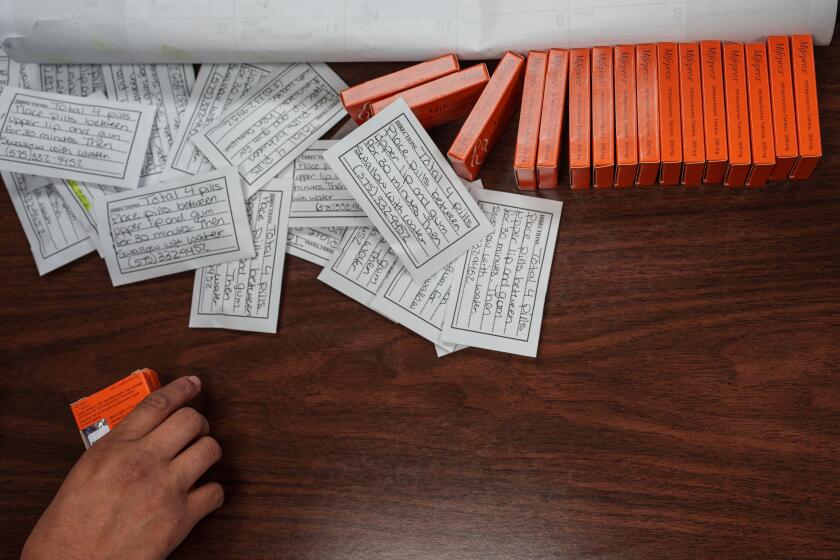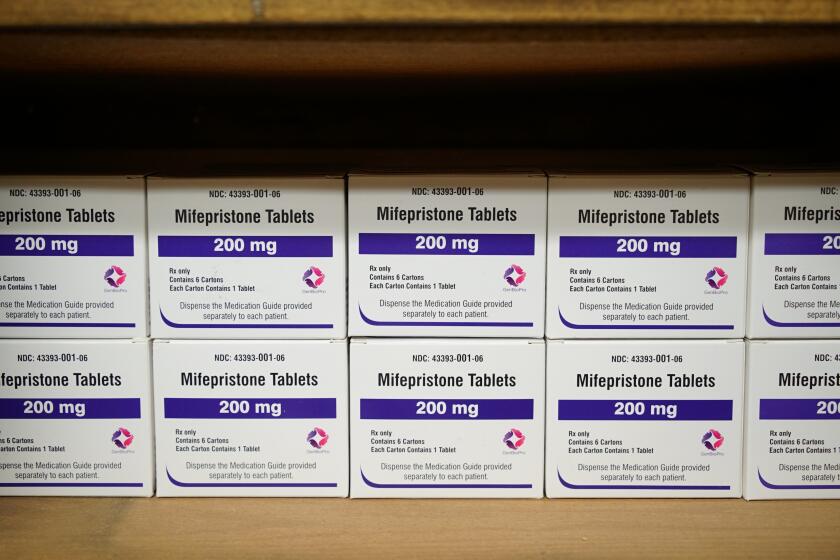The abortion pill faces its most disturbing attack yet

- Share via
Judge James Ho of the U.S. 5th Circuit Court of Appeals wrote an opinion last week that attracted a lot of attention. A three-judge panel that included Ho ruled in favor of further restrictions on access to mifepristone, the abortion pill, which will remain widely available under a Supreme Court order while litigation continues. But Ho also wrote a separate opinion contending that medical providers could further challenge the drug on the grounds of “aesthetic injury,” a concept he borrowed, strangely, from environmental law.
In what seemed a baffling argument, Ho wrote, “Unborn babies are a source of profound joy for those who view them. Expectant parents eagerly share ultrasound photos with loved ones. Friends and family cheer at the sight of an unborn child. Doctors delight in working with their unborn patients — and experience an aesthetic injury when they are aborted.”
Ho’s opinion cited multiple cases involving attempts to protect either wildlife or natural landscapes from harms that would diminish the viewing pleasure of nature lovers. He cited, for example, the 1972 Supreme Court case Sierra Club vs. Morton, in which the environmental group sought to block construction of a ski resort in California’s Sequoia National Forest on the grounds that the resort would harm the “area’s aesthetics and ecology.” He also cited the 1992 case Lujan vs. Defenders of Wildlife, which concerned standing to sue a government agency for spraying pesticides harmful to “beetles and butterflies that plaintiffs intended to view.”
“It’s well established,” Ho wrote, “that, if a plaintiff has ‘concrete plans’ to visit an animal’s habitat and view that animal, that plaintiff suffers aesthetic injury when an agency has approved a project that threatens the animal.”
In Ho’s legal analogy, then, patients undergoing abortion are akin to damaged natural landscapes or wildlife sanctuaries. Antiabortion doctors, meanwhile, play the role of disappointed tourists missing out on expected vacation pleasures.
A judge’s attempt to restrict medication abortion nationwide shows extremists aren’t done yet
When abortion is involved, science is often set aside while the political agenda of a small minority of Americans is weaponized, harming those who are or who will become pregnant by restricting their options.
Critics have noted the callous cynicism of Ho, a Trump appointee, draping his support for antiabortion activism in the mantle of purported environmental concern. Feminists have decried the demeaning paternalism implicit in likening pregnant women to animals.
Less examined has been the critical importance of the term “aesthetic” here. Unlike most arguments against abortion, which tend to equate it with murder, Ho criticizes it as causing aesthetic deprivation, denying doctors the pleasure they might derive from using medical imaging technology to peer into the interior of a woman’s body. His text makes frequent use of words like “view,” “image” and “sight.”
While this argument may have been advanced mainly as a legal maneuver to establish standing for the doctors trying to reverse mifepristone’s federal approval, it reveals a larger truth about the antiabortion movement. To construe abortion as a crime against the privilege of looking inside women is to construe them as objects offered up for the visual consumption, pleasure and, of course, control of others.
This is not a new concept. Psychoanalytic critics use the term “scopophilia” to refer to a presumably male audience’s erotic viewing enjoyment of the prurient presentation of women’s bodies in film or television, for example. Scopophilia objectifies women, turning them into visual surfaces to be looked at, embellished, augmented or reduced, perfected and consumed — in a word, commodified.
Ho’s opinion takes scopophilia to new depths, extending it below the surface of the skin into women’s bodily interiors, which he treats here as yet another category of viewable commodity, more subject to the controlling, pleasure-seeking gaze of medical providers than to the volition of the women themselves.
With abortion care virtually inaccessible in 13 states, it’s imperative to remove barriers where it remains legal.
It’s no accident that this opinion pertains specifically to nonsurgical abortion. By virtue of being a pill, mifepristone can make abortion invisible, often obviating the need for medical imaging or pelvic exams and thereby eliminating visual access to the procedure. Mifepristone can also reduce or even eliminate visual access to patients themselves: In many cases, a woman can get a prescription without an office visit and take the pill in the privacy of her home.
Mifepristone in this way offers women a powerful mode of resistance to the kind of compulsory bodily visibility that Ho advocates. Perhaps that’s why the judge chose the seemingly bizarre grounds of “aesthetic injury” to argue against access to the drug. It allows him to reposition abortion in the very realm from which mifepristone effectively frees it: that of prurient visual surveillance.
Rhonda Garelick is a distinguished professor of English and journalism at Southern Methodist University and the author of a forthcoming book on fashion and politics.
More to Read
A cure for the common opinion
Get thought-provoking perspectives with our weekly newsletter.
You may occasionally receive promotional content from the Los Angeles Times.











